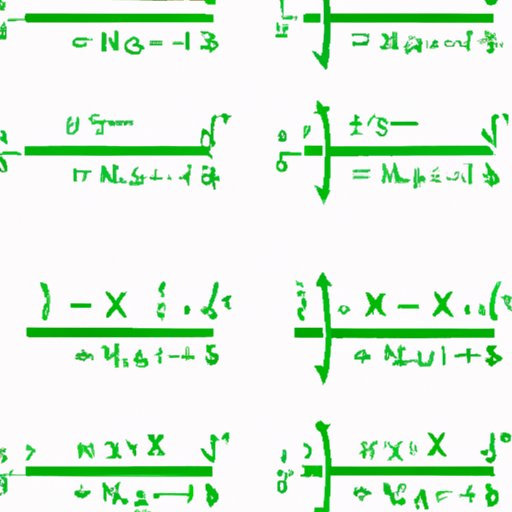Introduction
Understanding the range of a function is an essential skill for any mathematician. The range is the set of all possible output values of a function, and it plays a vital role in many mathematical calculations and real-world applications. Being able to find the range of a function allows you to determine important information about a function, such as its maximum and minimum values, and identify where it is increasing or decreasing. In this article, we will provide you with a comprehensive guide on how to find the range of a function.
Mastering the Basics: A Step-by-Step Guide to Finding the Range of a Function
Before we dive into more advanced techniques for finding the range of a function, it is essential to understand the basic steps involved in the process. The first step is to understand the function’s domain and codomain. The domain is the set of all possible input values of a function, while the codomain is the set of all possible output values.
The range is a subset of the codomain, which consists of all the values that the function outputs when given an input. To find the range, we need to analyze the behavior of the function over its domain.
One way to find the range is to identify the critical points of the function. Critical points are values where the function changes from increasing to decreasing or vice versa. Once we have identified critical points, we can use interval notation to determine the range. Interval notation is a method used to represent sets of numbers, and it is commonly used in calculus and algebra.
Cracking the Code of Finding the Range: Practical Tips for Success
Identifying the domain and codomain of a function is essential to finding its range. One tip for identifying the domain is to look for any restrictions on the input values of the function, such as square roots or logarithms. Another tip is to consider the context in which the function is being used, as this can help determine the valid input values.
When it comes to finding critical points, there are different strategies we can use depending on the function’s type. For example, for a quadratic function, we can use the vertex formula to find the vertex, which is a critical point. For trigonometric functions, we can use the period of the function to identify critical points.
We can also use calculus techniques, such as finding derivatives, to analyze the behavior of the function over its domain. This allows us to find the function’s increasing and decreasing intervals, which we can use to determine the range.
Solving the Mystery of Finding the Range: A Simplified Approach
While calculus techniques can be powerful tools for finding the range of a function, they may not always be necessary. Algebraic techniques can often be used to simplify a function, making it easier to find its range. For example, we can use the distributive property to factor out common factors in a function or use completing the square to rewrite a quadratic function in vertex form.
Once we have simplified the function, we can use the domain and critical points to determine the range. For a simpler function, graphing it may also be helpful in identifying its range. Graphing tools such as a graphing calculator can be particularly useful in visualizing a function’s behavior and finding its range.

Unleashing the Power of Finding the Range: Techniques and Examples
Now that we have covered the basics, let’s explore some more advanced techniques for finding the range of a function. For example, we can use the intermediate value theorem to determine if a function has a certain value in its range. This theorem states that if a continuous function is between two points, then it must take on every value in between those points.
We can also use mathematical software, such as Mathematica or MATLAB, to find the range of functions. These software applications often have built-in functions for finding the range, making the process faster and more efficient.
Unlocking the Secrets of Range: Essential Strategies for Mathematicians
One essential strategy for finding the range of a function is to understand the properties of specific functions. For example, trigonometric functions have a well-defined range, which can be determined based on the function’s period and amplitude. Exponential functions also have a defined range, which is determined by the value of their base.
Another key strategy is to practice, practice, practice. The more functions you work with, the more comfortable you will become with the process of finding the range. As you become more proficient, you may develop your techniques and shortcuts for finding the range quickly and accurately.
Navigating the Maze of Finding the Range: Key Principles and Tricks
When finding the range of a function, one common mistake people make is confusing it with the domain. Remember, the range is a set of output values, while the domain is a set of input values. Another common mistake is assuming that a function has the same domain and codomain, which is not always the case.
To avoid these mistakes, always work systematically, and double-check your work. Be sure to identify the function’s domain and codomain before attempting to find its range, and use interval notation to represent the range accurately.
Exploring the Depths of Finding the Range: Critical Steps and Calculations for Beginners
For those who want to take their skills to the next level, there are additional techniques that can be used to find the range of a function. For example, we can use the first and second derivatives to analyze the function’s concavity and inflection points, which can give us further insight into its behavior over its domain.
We can also use calculus techniques, such as finding limits or using L’Hopital’s rule, to find the range of more complex functions. Other advanced mathematical concepts, such as Fourier analysis or group theory, can also be used to find the range of specific types of functions.
Conclusion
In conclusion, finding the range of a function is an essential skill for any mathematician. It allows us to determine the maximum and minimum values of a function and identify where it is increasing or decreasing. By mastering the basics of finding the range and exploring advanced techniques, we can become more proficient and confident in using this skill. Remember to always work systematically and double-check your work, and continue practicing and exploring new techniques for finding the range.
